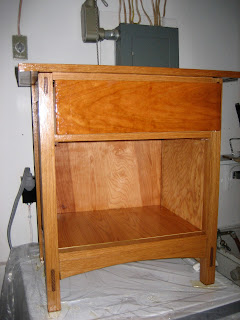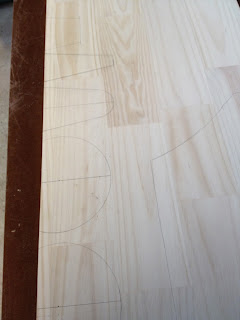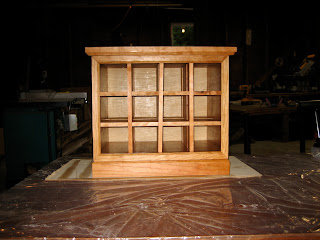This was something I've been considering for a while. The kitchen is small (not that I can change that) and the countertop is a hideous white speckled laminate. However, I have a goal of relocating the kitchen to a different part of the house, so I didn't want to put much money into the current one. And, I want a 36" range, so I don't want to replace the 30" I've got, no matter how rusty the stove top gets. (Kenmore no longer sells a replacement top for this stove.
Our inspiration was from A Country Farmhouse blog. (A blog well-worth perusing. Lovely.) White with a wood countertop.
I figured it would take me a few months to build and install the new cabinets. Well, it's now mid-July. Life, family, and weather have gotten in the way.
I've got the wall cabinets up -- although I still need to cut the shelves. And we haven't bought the hardware yet. More of the base cabinets are installed -- although I screwed up one of them and will have to re-build it.
Here is the original kitchen:
A few weeks back my friend Paul was in town and we ripped out old wall cabinets and hung the new ones:
I was shocked when everything fit. I will have to remake a door or two. Oops.
The doors are poplar frames with 1/4 birch plywood panels. I bought about 260 bf of rough poplar from a guy up here and milled and cut the boards myself. The hardware is Blum soft-close.
Ripping out the base cabinets, especially the plumbing, was harder than expected. It always is. But most of the cabinets are in place. I just need to shim the one on the left and screw it to the wall:
Again, a huge sigh of relief when that corner unit fit perfectly between the range and the dishwasher. The floor slopes quite a bit down to the left, so there was a lot of shimming going on. But it's all level and square.
We decided on an apron front sink purchased from Overstock.com. It's about twice as expensive as I wanted, but I do like the look of it.
The sink is about 100 pounds, so I had to re-work the cabinet to put in that shelf and some supporting pieces underneath. I hope it holds. And, I decided to call a plumber for when we're ready -- I don't think I can handle learning how to plumb. That will be for the future.
The counter top will be alder, from Perfect Plank. The whole top cost about $450, delivered, which is about 1/4 the price of anything else I looked into. I will have to finish it myself, but that shouldn't be too hard.
I had taken off work last Thursday and Friday (after July 4th) to finish the sink and the counter top. Of course, the sink was damaged. As was the counter top. That will be work for next weekend.
And then, I need to build drawers.
So far, with all of the hardware, I'm about $2,500 into the project. Most of the cost is hardware -- the hinges and drawer slides (Blum Tandem undermounts -- with the cool soft close feature). Still, I should be able to get everything done for the price of a decent Corian counter top.



























